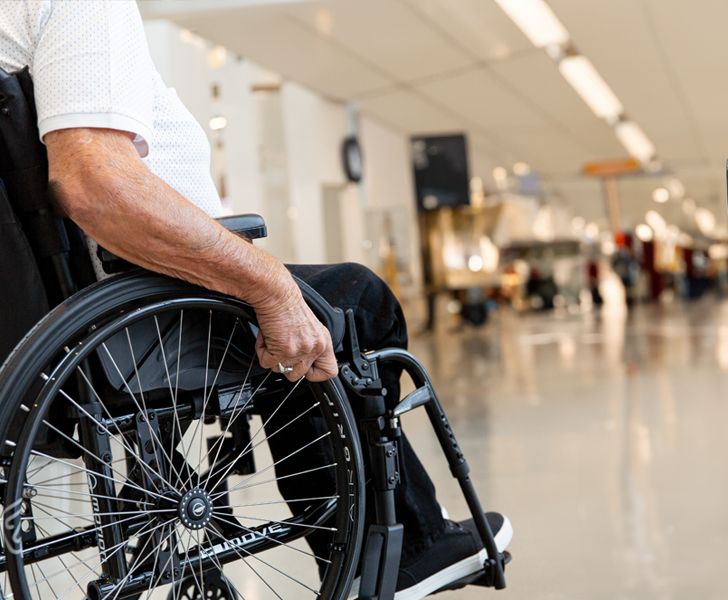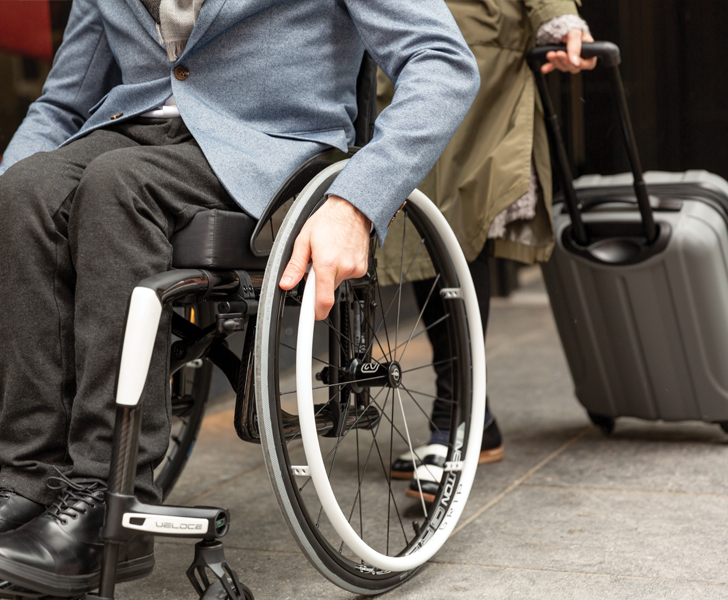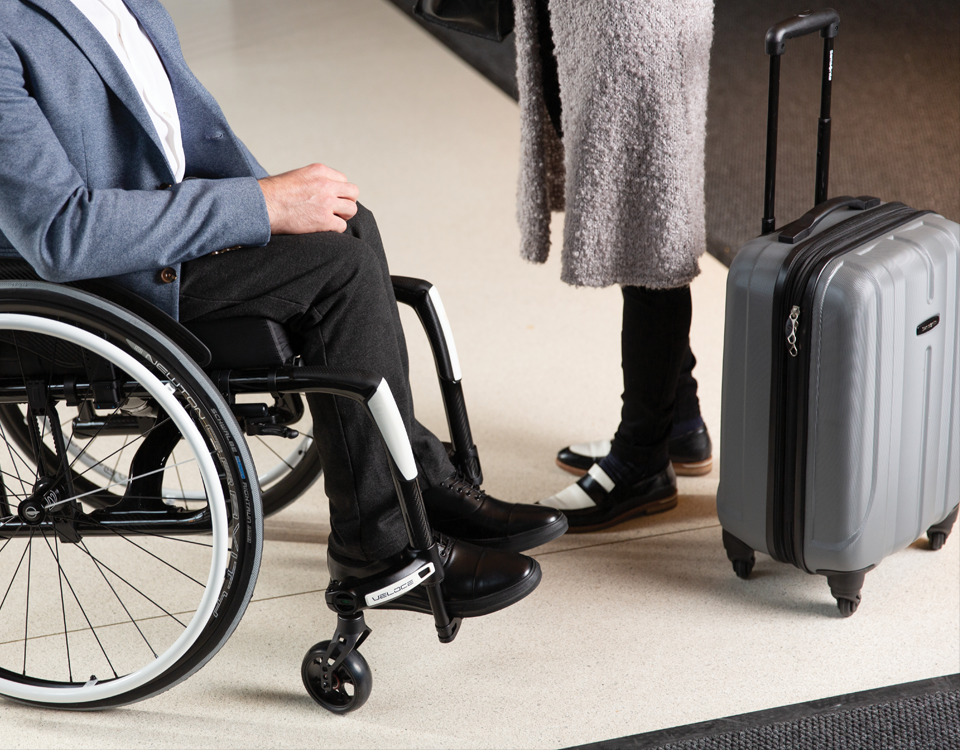Air Travel as a Wheelchair User: A Complete Guide
Discovering the world should never come at the expense of your health or your mobility equipment. However, this is not the reality for all the disabled community.
Discovering the world should never come at the expense of your health or your mobility equipment. However, this is not the reality for all the disabled community.
Traveling should be an enjoyable experience for everyone, but for wheelchair users, traveling by plane tends to be a stressful process that involves potential damage to their mobility equipment, resulting in extra costs, insurance claims, and dealing with air travel companies. To help you prepare for air travel, we have gathered everything you need to know before booking that ticket to your next paradisiac destination.
The most important tip is to Know Your Rights: Familiarize yourself with the Air Carrier Access Act (ACAA), which prohibits discrimination based on disability in air travel. This includes provisions for boarding, deplaning, and accessibility on the aircraft.
As a wheelchair user, it is important that you book in advance. Don't forget to notify the airline of your wheelchair use and any specific requirements at the time of booking; this includes arranging assistance from the airline if needed, such as wheelchair assistance from check-in to the gate, boarding assistance, and assistance with transfers between flights. This allows them to make necessary arrangements and accommodations for you and your specific needs.
Whenever possible, try to choose direct flights to minimize the number of transfers and reduce the chances of complications. If possible, select a seat that meets your needs, whether it's an aisle seat for easier access or a bulkhead seat for more legroom.
Pro tip: Pack essential items such as medications, personal care items, and any necessary medical supplies in your carry-on luggage to ensure they are easily accessible during the flight.
Before going to the airport, make sure that you check its accessibility. Check for parking options, if necessary, accessibility options for getting in and out of the airport, check-in options, and services offered for people with disabilities.
Arrive at the airport well in advance to allow extra time for check-in, security screening, and boarding. Airlines typically recommend arriving at least two hours before domestic flights and three hours before international flights.

Inform the Transportation Security Administration (TSA) officers if you need any assistance during the security screening process. They are trained to provide additional support to travelers with disabilities.
It is important to remember that even if you are an ambulatory wheelchair user, you do not need to get out of your wheelchair to pass through the metal detectors. TSA officers are trained, so you receive a screening by way of a pat down. (Learn more about this procedure on WheelchairTravel.org website by clicking here).
Pro tip: If you want a less invasive, quicker-turnaround TSA in the United States of America, make sure to apply for TSA PreCheck or Global Entry.
These trusted traveler programs require extensive background checks but provide expedited security screenings at the airports.
Canada: Verified Traveler program
United Kingdom: Registered Traveller Program
Germany: EasyPASS
If you are traveling to other countries, make sure to check if they have a similar program available and if you can apply to it.
Be familiar with the dimensions and weight of your wheelchair, as airlines have different policies regarding the transportation of mobility devices.
If you have a battery-powered wheelchair or a power-assisted device that is attached to your wheelchair, make sure to check that it complies with the specific airline regulations.
Make sure to remove any loose parts or anything that can potentially fall off your wheelchair and ask to have it put in the plane’s closet. This includes the side guards, armrests, etc.
Some people like to wrap their wheelchairs in pipe isolation and electrical tape to avoid general scratches since the airlines are not always conscious of how delicate mobility equipment can be and they don’t go easy on them. The majority of the time, airlines tend to put the wheelchairs on its side, exposing the handrims and wheels to rough surfaces.
Take your cushion with you in the cabin; you can use it during the flight and avoid potential pressure sores.
Don’t forget to take pictures of your mobility equipment before the airline checks it. This is proof of the estate of your mobility equipment before the flight, and it will make it easier to report any damage or loss that could potentially incur.
Label your wheelchair and other mobility aids with your name and contact information to prevent loss or confusion.
Putting signs with instructions can be helpful, but be aware that the people handling it may not take the time to read it. You can try to add more visual signs that indicate how to properly handle the chair or simply say “fragile”.
Everyone deserves to have a comfortable flight, and even if your needs as a disabled person vary from those of fully abled people, they are just as important.
Since you are a wheelchair user, you have priority boarding, as you may need some extra time to settle in your seat. Take your time and don’t feel pressured to transfer faster than you should.
Let the crew know if you need some assistance or if you need to move to go to the bathroom. The flight crew has been trained to assist disabled users.
If your flight is a long one, make sure to change position every once in a while to avoid any potential pressure sores.
Once the plane arrives at the gate, they will let everyone else get off the plane before they assist you. This will give them time to get your wheelchair and bring it to the gate for you to transfer into it.
When you get the chair back from the handlers, be sure to examine it closely and ensure that all functions work properly. If you notice any damage, notify the people at baggage claim immediately. They can’t do anything at the gate, but it can be helpful to mention the damage to the people around at the time.
IMPORTANT: Don’t leave the airport without filing a claim.

You arrive at your destination only to realize that your precious mobility equipment has been lost or damaged by an airline during travel. Don’t panic! Here are steps you can take to address the issue:
Report the Damage Immediately: As soon as you notice the damage, report it to airline staff at the airport. Document the damage with photos if possible. Ensure you obtain a written report or damage claim form from the airline. Again, don’t leave the airport without filing a claim.
Request Immediate Assistance: Ask the airline for assistance in addressing your immediate mobility needs. This might include arranging for a temporary replacement wheelchair or other mobility aid if necessary.
File a Damage Claim: File a formal damage claim with the airline as soon as possible. Provide detailed information about the damage, including the make and model of the equipment, the extent of the damage, and any repair estimates or invoices you receive.
Keep All Documentation: Keep all documentation related to the incident, including your boarding pass, baggage claim ticket, and any communication with airline staff. This can be important for follow-ups on your claim, or for seeking compensation.
Follow Up Regularly: Follow up with the airline regularly to check on the status of your claim. Be persistent in seeking resolution and reimbursement for the damage.
Know Your Rights: Familiarize yourself with your rights as a passenger under the Air Carrier Access Act (ACAA) and any applicable airline policies regarding compensation for damaged mobility equipment. The ACAA requires airlines to make prompt and appropriate accommodations for passengers with disabilities, including repairing or replacing damaged mobility aids. You can also do
Seek Compensation: Depending on the extent of the damage and the airline's response, you may be entitled to compensation for repair costs, replacement equipment, or other related expenses. Be prepared to negotiate with the airline if necessary to reach a satisfactory resolution.
Finally, suppose the airline fails to address the damage or compensate you for your losses. In that case, you may consider seeking legal advice or assistance from a consumer rights organization specializing in disability rights.
Remember to remain calm and assertive when addressing damage to your mobility equipment with the airline. By following these steps and advocating for your rights, you can work toward a resolution and ensure your needs are met for future travel.
We know that traveling by air can be stressful, and if you fear that your mobility equipment could get damaged, it only makes it much more stressful. On a good note, the airlines do have a third party that ensures that repairs are done promptly.
Yes, a lot has improved, but there is still much to be done. Wheelchair users deserve the right to have a comfortable experience when flying, and we must continue advocating for accessibility and inclusion EVERYWHERE, even in the sky! Check this article by the United Spinal Association on advocating for safe air travel for wheelchair users.
We hope that this blog has been useful. Don’t forget to check out our resources in the links below, which will help provide even more information on air travel for wheelchair users.
TSA Security Screening – What to expect
Wheelchair User’s guide to air travel – WheelchairTravel.org
